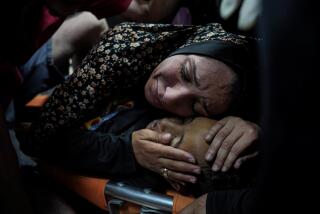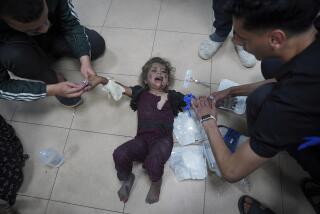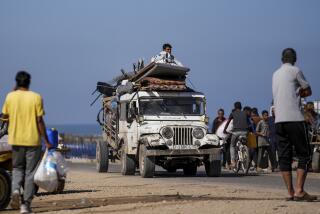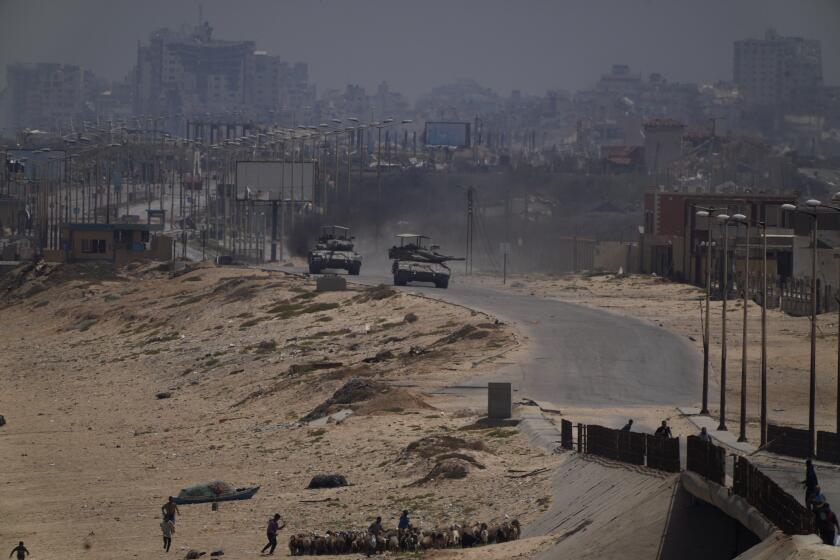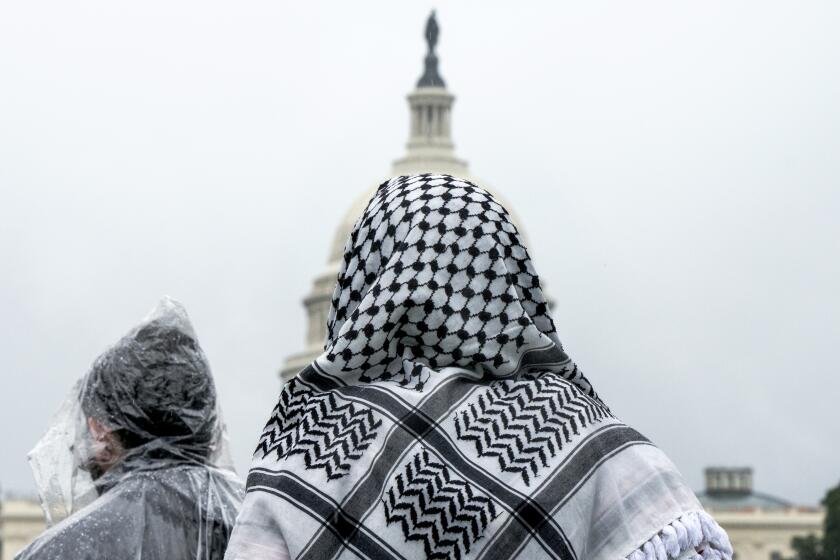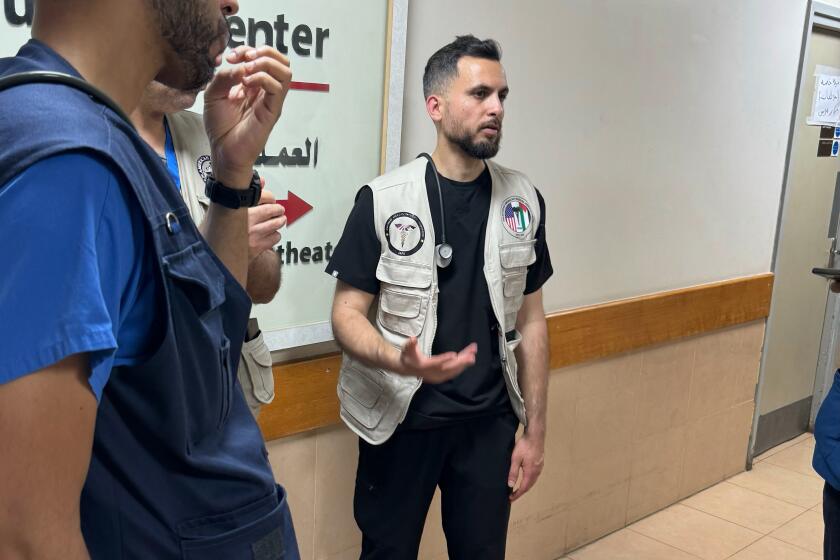Hamas says it accepts cease-fire as Israel orders Palestinians to evacuate eastern Rafah

Hamas announced Monday that it had accepted a cease-fire agreement with Israel in Gaza, a diplomatic breakthrough that came hours after Israel ordered civilians in eastern Rafah to evacuate in what was seen as a prelude to a long-anticipated offensive on the area.
Israel has yet to accept the terms and launched a new wave of air strikes late Monday against sites in Rafah but said it would dispatch a delegation to finalize details, even though significant gaps in the agreement remained.
Hamas said the head of its political bureau, Ismail Haniyeh, spoke by phone with the Qatari prime minister and the Egyptian minister of intelligence to inform them of the group’s “approval of their proposal regarding the cease-fire agreement.”
The cease-fire is seen as key to the release of some of the dozens of hostages, including several Americans, who have been held in Gaza since the Hamas attack on southern Israel on Oct. 7, in which nearly 1,200 Israelis and others were killed. More than 34,000 Palestinians have been reported killed in the massive airstrikes and land operations Israel launched in response.
Monday’s announcement — during which Hamas released some details of what it said was in the proposal — marked a moment of optimism after months of agonizing negotiations, with Qatar, Egypt and the United States pushing for a cease-fire that remained stubbornly out of reach. It came after CIA Director William Burns spent the weekend shuttling among Arab capitals in intense last-ditch talks to push the cease-fire agreement.
“We will be encouraged when we get the deal in place and we can start seeing hostages getting back to their families,” White House national security spokesman John F. Kirby said Monday when asked to gauge prospects of a successful cessation of hostilities. “We are at a critical stage right now.”
Hamas made its announcement hours after Israel’s military began dropping leaflets in eastern Rafah ordering people to evacuate immediately. Israel has been threatening for weeks — against U.S. advice — to launch a major military ground operation in the city where more than 1 million displaced Gazans have taken refuge. Israel argues that the last remaining Hamas battalions are holed up in Rafah, while the U.S., United Nations and others say any military invasion would unleash a humanitarian disaster there.
Already, tens of thousands of Palestinians in Gaza face starvation because fighting and destruction have made the delivery of food, medicine and water extremely difficult, aid officials say.
In recent days, Israel insisted that an attack on Rafah would take place whether a deal was made or not, and that a truce would not include an end to hostilities, which Hamas demanded as a condition for any deal. That difference between an overall cessation of hostilities, as the Palestinian side seeks, and Israel’s intention to continue its military offense has not been bridged.
Palestinian officials said the Israeli airstrikes against sites in Rafah killed several dozen civilians. The Associated Press reported that Israeli tanks moved into the region within 200 yards of the border with Egypt.
Israel claimed the attacks were “limited” and “targeted” air strikes. The U.S. did not immediately comment on the new wave of attacks amid the cease-fire negotiation.
Still, speaking earlier, Egyptian and Hamas officials said the deal as agreed to thus far comprises several phases. Under the first phase, which includes a six-week cease-fire, the militant group would release 33 civilian hostages. Israel in return would release about 800 Palestinian prisoners and allow displaced Gaza residents to return to their homes in the northern part of the coastal enclave.
The second phase also lasts 42 days and involves the release of the remaining hostages, including soldiers, for a thus-far unspecified number of Palestinians; it would also aim to finalize arrangements for a permanent end to fighting.
The “main goal is a permanent cease-fire, or the return of sustainable calm which would achieve a permanent cease-fire; the full [phased] withdrawal [by Israel] from the Gaza Strip; and the return of the displaced,” Khalil Al-Hayya, a senior Hamas official, told Al-Jazeera television.
A “serious” release of Palestinian detainees held by Israel, the arrival of more humanitarian aid and first steps to rebuilding the Gaza Strip are other elements that would come gradually, Al-Hayya said.
The first group of hostages to be freed would be women, including female soldiers; anyone under 19 or over 50; and the sick, Al-Hayya said. For each Israeli woman and child released, 30 Palestinian women and children would be released from Israeli prisons. Fifty Palestinian detainees sentenced to long prison terms would be released for each female soldier.
Al-Hayya said the U.S., Qatar and Egypt will serve to verify compliance with the cease-fire, but Doha and Cairo will insist that hostilities not resume.
“The ball is now in Israel’s court,” he said.
The Biden administration has repeatedly said it believed the “ball was in Hamas’ court” because Israel had made what it termed a generous offer on the cease-fire/hostage deal. U.S. officials accused the militant group of moving the goalpost in the negotiations.
That said, the administration vehemently opposes a major invasion of Rafah because of the inevitable loss of life in the overcrowded refuge. President Biden recently told Prime Minister Benjamin Netanyahu that the enormous quantities of U.S. military aid to Israel might be jeopardized if the country did not take better care to protect civilians.
“We have made clear we don’t support Israel launching a full-scale military operation on Rafah,” State Department spokesman Matthew Miller said Monday. He said that there were “better ways” to “take on” the Hamas battalions that remain in Rafah, and that the U.S. has outlined those to Israel. He declined to describe them.
Some diplomats suggested that Israel’s apparent preparations to go ahead with the Rafah invasion early Monday were a way to pressure Hamas to accept the deal.
The Israeli military released a statement on X saying it had called on civilians in eastern Rafah to move temporarily to what it described as an “expanded humanitarian area” in Mawasi on Gaza’s coast. The humanitarian area, it said, has “field hospitals, tents and increased amounts of food, water, medication and additional supplies.” The statement added that evacuation calls “will be conveyed through fliers, SMS messages, phone calls and media broadcasts in Arabic.”
On Monday morning, Israeli warplanes began to drop leaflets on Rafah, warning those in the Rafah and Brazil camps and the neighborhoods of Shabura and Zohour to evacuate. The leaflets said the Israeli military “will act with great force against terrorist organizations in your areas of residence” and that anyone nearby would be exposing themselves to danger. The fliers added that Gaza City, home to many displaced people, remained an area for combat operations, and that people should not try to return to the northern part of the enclave.
Many Gazans have fled to zones created by Israel as safety areas, only to be attacked there, Palestinians say.
“The relocation orders issued by Israel today to thousands of Gazans, directing them to move to Al-Mawasi, are beyond alarming,” said Jan Egeland, secretary general for the Norwegian Refugee Council aid group, in a statement released Monday. “The area is already overstretched and devoid of vital services.”
Bulos reported from Beirut and Wilkinson from Washington.
More to Read
Start your day right
Sign up for Essential California for news, features and recommendations from the L.A. Times and beyond in your inbox six days a week.
You may occasionally receive promotional content from the Los Angeles Times.
